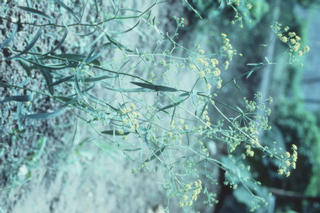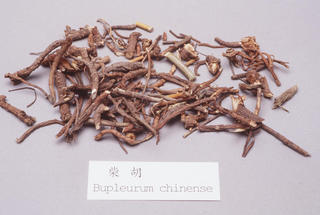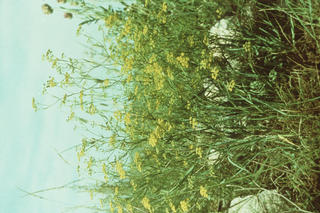Bupleurum scorzonerifolium
Contents
Nomenclature
Other Names:
Historical Use of Bupleurum scorzonerifolium
Bupleurum scorzonerifolium in Traditional Chinese Medicine
Background
Beichaihu ±±²ñºú
Chunchaihu ´º²ñºú
Cuchaihu ´×²ñºú
Nenchaihu ÄÛ²ñºú
Chinese Name (pinyin): Chaihu
Chinese Name :
Common Name :Bupleurum Root
Specific Name : Radix bupleuri
Scientific Name:
Collection : The drug is collected in spring and autumn, removed from aerial part, soil and dried
Description : Bei Chaihu: Cylindrical or elongated conical, 6 - 15 cm long, 0.3 - 0.8 cm in diameter, root stock expanded. Apex remained with 3 - 15 stem bases or short fibrous leaf bases, branched at the lower part. Externally blackish brown or light brown with longitudinal wrinkles, rootlet scars and lenticels. Texture hard and tenacious, uneasily broken, fracture laminated-fibrous, bark light brown, wood yellowish white. Odour slightly aromatic and taste slightly bitter.NanChaihu: relatively thin, conical apex with numerous hairy fibres from withered leaves, usually not branched at the lower part. Externally reddish brown or blackish brown with dense and transverse annulations near the root stock. Texture slightly even, nonfibrous, odour rancid.
Identification : 1.To 0.5g of the powder add 10 ml of water, shake vigorously, a persistent foam is produced.2.To 0.5g of the powder add 20 ml of methanol, heat at 80ºC under reflux for 1 hour, cool down and filter. Evaporate the filtrate to about 5 ml and used it as the test solution. Dissolve saikosaponin, a saikoponin in methanol to produce a solution containing each of 0.5 mg per ml as the reference solution. Carry out the method for thin layer chromatography (Appendix Vl B), using silica gel G as the coating substance and ethyl acetate-ethanol-water (8;2:1) as the mobile phase. Apply separately to the plate 5µl of each of the two solutions. After developing and removal of the plate, dry it in the air, spray with 5% solution of dimethylaminobenzaldehyde in 40% sulfuric acid, heat at 60ºC until the spots appear. Examine under sunlight and ultra violet light (365 nm) separately. The spots or the yellow fluorescent spot in the chromatogram obtained with the test solution correspond in position and colour to the spot in the chromatogram obtained with the reference solution.Total ash: Not more than 8.0% (Appendix lX K)Extractives: Carry out the hot extractions method described under the determination of ethanol-soluble extractive (Appendix X A), using ethanol as solvent, not less then 11.0%
Processing : Remove from foreign matter and remains of stems, wash clean, soften thoroughly, cut into thick slices and dry.Processed with vinegar: Stir fry the slices as described under the method for stir frying with vinegar (Appendix ll D) to dryness.
Action : To relieve fever, to soothe the liver, and to cure drooping and ptosis.
Indication : influenza or common cold with fever; alternate colds and fever such as malaria; distending pain in the chest and hypochondriac regions; menstrual disorders; prolapse of the uterus, prolapse of the rectum
Precautions : The dried rhizome of Bupleurum longiradiatum Turzo, covered with numerous annular nodes externally is poisonous and cannot be used as Radix Bupleuri.
Dosage : 3 to 9 g.
Storage : Preserve in a ventilated dry place, protected from moth.
Synonymns for Bupleurum scorzonerifolium
Patent Medicines and Medicines with Multiple Ingredients that include Bupleurum scorzonerifolium
Pharmaceutical Information
Chemical Constituents
Evidence or the Use of Bupleurum scorzonerifolium in the Treatment of Epilepesy
Basic Science
Animal Studies
Cohort, Case-Control and Non-Randomized Trials
Randomized Controlled Trials
Meta-Analysis
1st Five Results: pubmed search
Zi-Wei Li, Jia-Tong Wu, Yu Bi, Meng-Meng Li, Anam Naseem, Juan Pan, Wei Guan, Zhi-Chao Hao, Hai-Xue Kuang, Qing-Shan Chen, Li-Li Zhang, Yan Liu, Bing-You Yang
##Title##
Nat Prod Res: 2024;1-8
[PubMed:38597194]
[WorldCat.org]
[DOI]
(I a)
Zhongyuan Qu, Yan Zheng, Shuang Wu, Yifan Bing, Zhiwei Sun, Shiru Zhu, Wenlan Li, Xiang Zou
Two Omics Methods Expose Anti-Depression Mechanism of Raw and Vinegar-Baked Bupleurum Scorzonerifolium Willd.
Chem Biodivers: 2024, 21(4);e202301733
[PubMed:38217462]
[WorldCat.org]
[DOI]
(I p)
Yupeng Cheng, Yuanzhen Liu, Xinhong Li, Guangjie Liu, Zhongmeng Li, Bo Liu, Ning Gao
Transcriptome analysis of the mechanism of endophytic fungus CHS3 promoting saikosaponin d synthesis in Bupleurum scorzonerifolium Willd. suspension cells.
Fitoterapia: 2024, 173;105778
[PubMed:38128620]
[WorldCat.org]
[DOI]
(I p)
Yue Tong, Ge Zhao, Ruonan Shuang, Hanqing Wang, Nan Zeng
Saikosaponin a activates tet1/dll3/notch1 signalling and promotes hippocampal neurogenesis to improve depression-like behavior in mice.
J Ethnopharmacol: 2024, 319(Pt 3);117289
[PubMed:37844745]
[WorldCat.org]
[DOI]
(I p)
Su-Nan Li, Yi-Fan Bing, Shuang Wu, Long-Tan Luo, Zhi-Wei Sun, Wen-Lan Li, Zhong-Yuan Qu, Xiang Zou
Discovery and verification of anti-inflammatory-related quality markers in the aerial part of Bupleurum scorzonerifolium by UPLC-Q-TOF-MS/MS and in RAW 264.7 cells and a zebrafish model.
Phytochem Anal: 2024, 35(2);336-349
[PubMed:37787024]
[WorldCat.org]
[DOI]
(I p)


